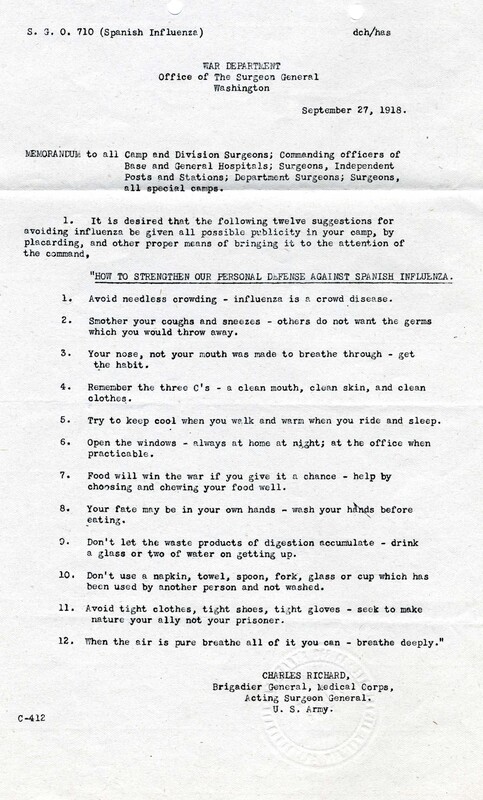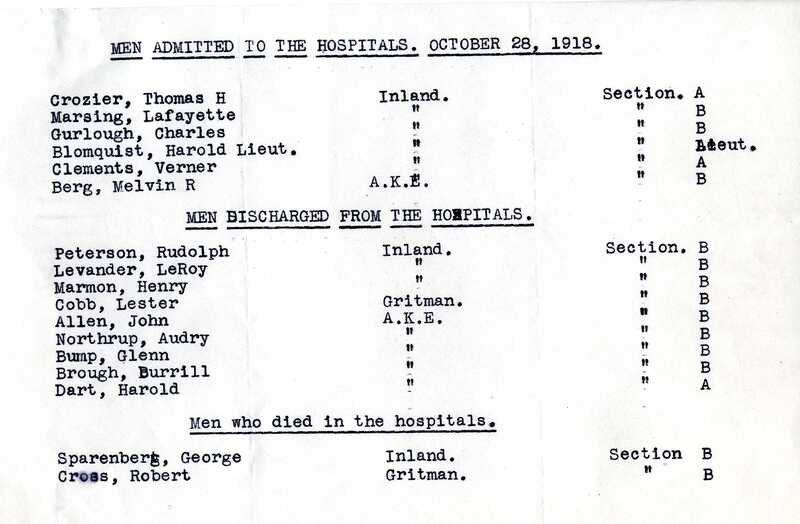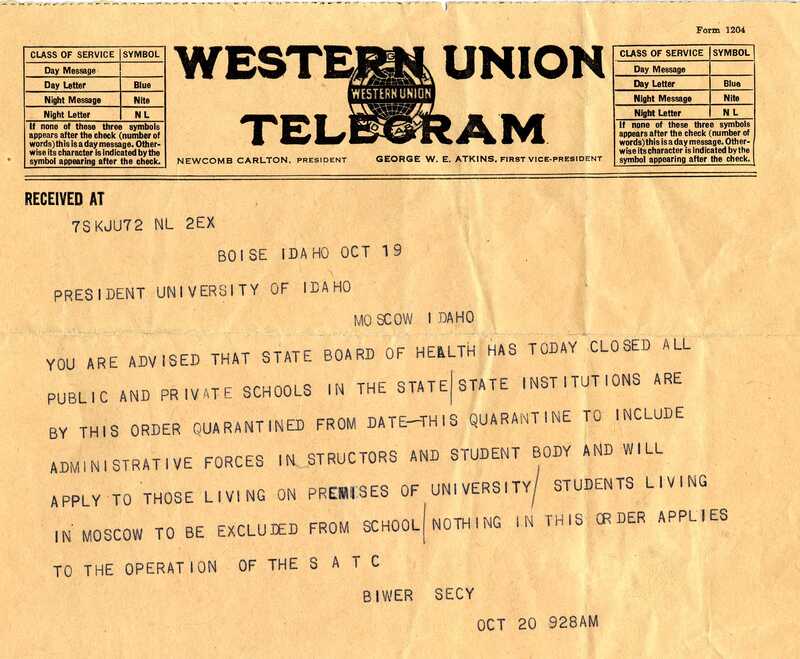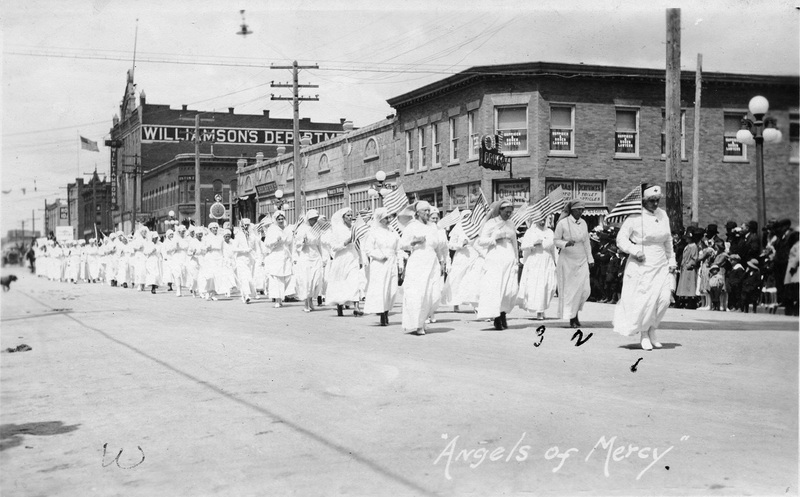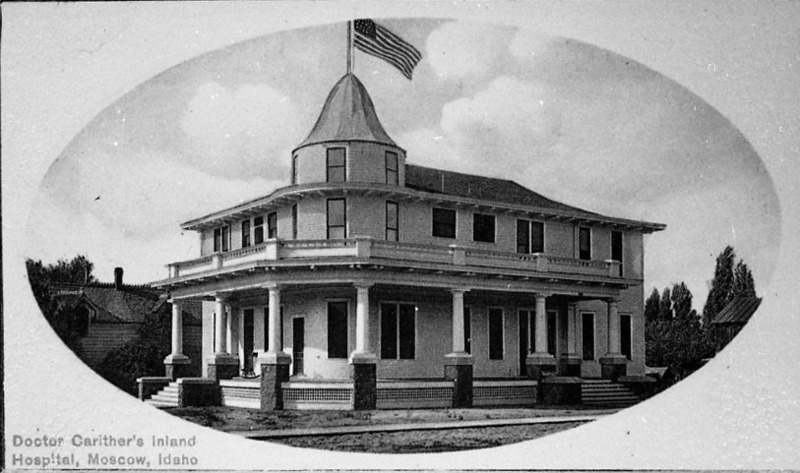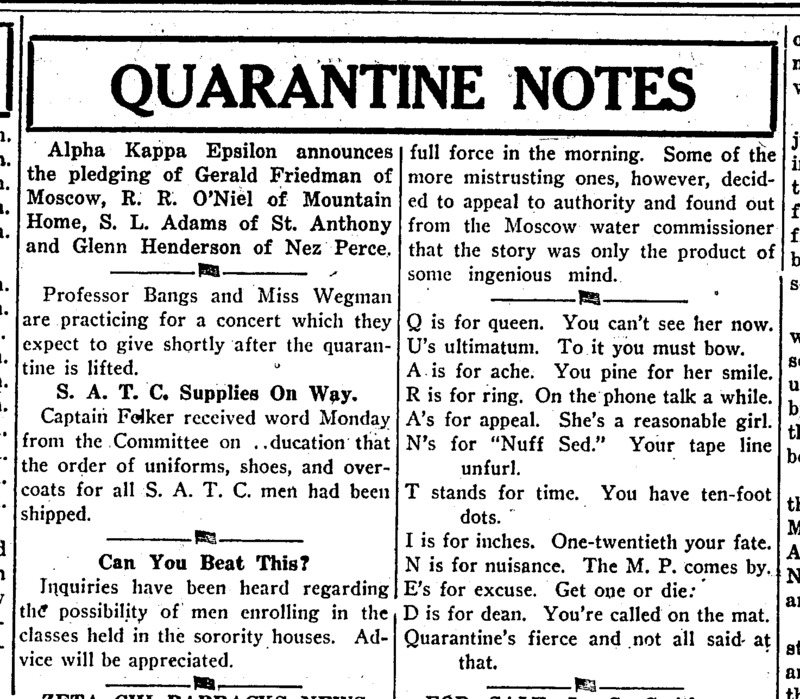Contents: The 1918 Influenza | The University's First Cases | Patient Care and Community Response | University Quarantine | About the Collection | References | Tech
The 1918 Influenza
In 1918 the world experienced what is considered the most severe pandemic in modern history, the Influenza of 1918. Also known as the Spanish Flu, the disease was far reaching, infecting an approximated 500 million people worldwide. In three waves spanning 15 months the influenza killed an estimated 50-100 million people worldwide with 675,000 deaths in the United States alone.1
The effects of the pandemic occurred in three waves. The first, and mildest, wave of the influenza arrived in the spring of 1918. During this wave, fewer people died and many of those infected recovered after a couple of days. The second wave, which proved to be the most deadly and virulent of the three, arrived in the Fall of 1918.2 Idaho reported its first cases of the influenza in September in Canyon County, and by October there were cases across the state from Coeur d’Alene to Pocatello, including several at the University of Idaho.3
The University of Idaho’s first cases were diagnosed in soldiers who had joined the Student Army Training Corps (SATC). In the weeks following these diagnoses, the university and state took direct action to prevent its spread by issuing quarantine orders, requiring face coverings, and advising all to avoid large crowds.
The third and final wave of the influenza arrived worldwide in the winter and spring of 1919, and by that time most of the cases were resolved at the University of Idaho. By summer of 1919, the virus had run its course and the pandemic was over.
The University’s First Cases
Starting in the fall of 1918, the University of Idaho began receiving hundreds of young men to the Student Army Training Corps (SATC). The SATC was a program created by the US War Department to provide a way for young men to train as soldiers while also taking college courses. At the University of Idaho, approximately 500 men entered the program in two sections for academic and vocational training.4
In mid-October, SATC men from across the country arrived at the University of Idaho. They brought with them three mild cases of the influenza. Upon these cases being diagnosed, university administration took immediate action, closing the university for several days as a preventative measure against the spread of the disease.
Days after the university’s decisions, President Lindley received word that the State Board of Health was enacting a quarantine on all state institutions. Overall, approximately 200 SATC men were estimated to have become infected and 12 reportedly died due to the virus.
Patient Care and Community Response
Before the influenza hit the university, physicians and medical professionals were in short supply across the nation, as many doctors and health workers were serving their country in the military. Consequently, many communities were unprepared to care for the vast number of cases that would ultimately come their way. This situation became even more dire after health care professionals began to catch the infection themselves and were no longer able to care for others.
In communities with a shortage of doctors, the American Red Cross served a vital role in fighting the disease. Across the nation, the organization recruited thousands of nurses and volunteers who worked to provide equipment and supplies to hospitals, feed and care for influenza patients, and provide additional services.5
Many community members of Moscow and the University of Idaho joined the Red Cross to help the war effort, and when the virus began affecting the region, these volunteers began caring for patients and coordinating nursing efforts in the area.
As more members of the SATC were diagnosed with the influenza, more space was needed and multiple auxiliary hospitals were established to help care for the patients. While the most severe cases of the influenza were sent to Gritman Hospital, the fairly severe cases were attended to at a privately owned hospital called the Inland Hospital, which served as the headquarters for SATC patients. Additionally, several houses in town were used for mild cases and those recovering, most notably the Alpha Kappa Epsilon House and the Elks Club House.
University Quarantine
When the quarantine went into effect, many university activities were cancelled. Students living off campus were not allowed to attend classes. Steps were eventually taken so these students could receive a health certificate allowing them to return to campus to resume classes. However, once they were on campus during the quarantine, they could not leave again.
Many of the women on campus took an active role to fight against the pandemic during quarantine. Women in home economics classes cooked meals for patients, women living groups on campus made gauze masks for patients, and women across campus and the community served as nurses working with the local Red Cross.
Not all activities were banned across campus, but many social activities, such as parties and dances, were indefinitely postponed. Living groups remained active in whatever ways they could and recorded these activities in the University Argonaut’s “Quarantine Notes.”
About the Collection
This collection was compiled by Courtney Berge and Devin Becker from several collections held by the University of Idaho Library. Content on the about page and timeline featured on the collection home page were written by Courtney Berge. The collection website was built using the library’s own CollectionBuilder.
References
-
1918 Pandemic (H1N1 Virus), Centers for Disease Control and Prevention, National Center for Immunization and Respiratory Diseases (NCIRD), https://archive.cdc.gov/#/details?url=https://www.cdc.gov/flu/pandemic-resources/1918-pandemic-h1n1.html Accessed 27 August 2025. ↩
-
1918 Pandemic Influenza: Three Waves, Centers for Disease Control and Prevention, National Center for Immunization and Respiratory Diseases (NCIRD), https://archive.cdc.gov/www_cdc_gov/flu/pandemic-resources/1918-commemoration/three-waves.htm. Accessed 27 August 2025. ↩
-
1918-1919 Influenza Pandemic In Idaho, Idaho Department of Health and Welfare, https://web.archive.org/web/20201016195841/http://www.healthandwelfare.idaho.gov/Portals/0/Health/ReadyIdaho/IdahoFluHx.pdf. Accessed 27 August 2025. ↩
-
Fourth Biennial Report of the State Board of Education and Board of Regents of the University of Idaho. Idaho Bulletin of Education, vol. VII, no. 1, State Board of Education, January 1921, Boise, Idaho. ↩
-
Jones, Marian Moser. “The American Red Cross and local response to the 1918 influenza pandemic: a four-city case study.” Public health reports, vol. 125, suppl 3, 1974, Washington, D.C., pp 92-104. doi:10.1177/00333549101250S312 ↩
Technical Credits - CollectionBuilder
This digital collection is built with CollectionBuilder, an open source framework for creating digital collection and exhibit websites that is developed by faculty librarians at the University of Idaho Library following the Lib-Static methodology.
Using the CollectionBuilder-CSV template and the static website generator Jekyll, this project creates an engaging interface to explore driven by metadata.

